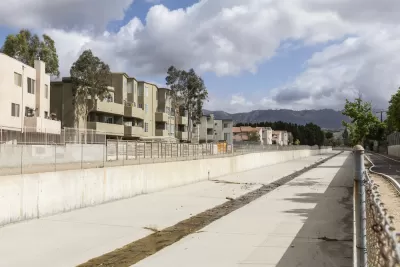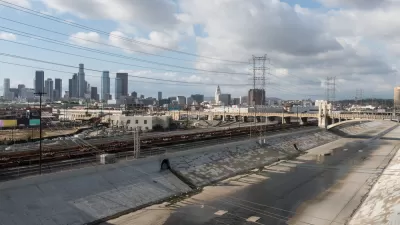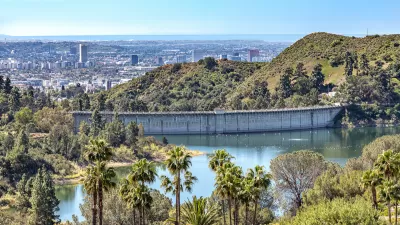In the past, stormwater management has been about flood control. The future of stormwater, however, is in capturing, treating, and recharging water supply, according to this article.

Chris Austin, otherwise known as the Maven of California water news, shares a presentation from Dr. Richard Luthy, a professor of civil and environmental engineering and the director of the National Science Foundation’s Engineering Research Center, describing the evolution of stormwater infrastructure.
According to Luthy, a shift away from stormwater management as flood control would bring multiple benefits. Not only would urban areas like Los Angeles gain critical water supply for a growing population, "it would provide other community benefits, like cleaning the beaches."
Luthy is building on existing plans by the city of Los Angeles to cut the amount of water supply it imports by half:
How is that achieved? One of the solutions is stormwater capture, and on this drawing, it says the stormwater would be 4% of the urban water supply, and in a moment I’ll show you that it could really be much more than that. It could be 3, 4, maybe even 5 times that if plans come into being in this century.”
In addition to an appeal to use bigger systems to achieve more ambitious goals, Luthy also shows how stormwater capture infrastructure can become open space and recreation facilities during dry seasons (e.g., hiking trails, basketball courts, and playfields). Finally, Luthy detailed the processes that would be necessary to treat stormwater runoff that could potentially be contaminated with pathogens, organics, and nitrates.
Renderings, schematics, and other infographics drawn directly from Luthy's presentation supplement the article.
FULL STORY: Stormwater capture, treatment and recharge for urban water supply

Trump Administration Could Effectively End Housing Voucher Program
Federal officials are eyeing major cuts to the Section 8 program that helps millions of low-income households pay rent.

Planetizen Federal Action Tracker
A weekly monitor of how Trump’s orders and actions are impacting planners and planning in America.

Ken Jennings Launches Transit Web Series
The Jeopardy champ wants you to ride public transit.

Washington Legislature Passes Rent Increase Cap
A bill that caps rent increases at 7 percent plus inflation is headed to the governor’s desk.

From Planning to Action: How LA County Is Rethinking Climate Resilience
Chief Sustainability Officer Rita Kampalath outlines the County’s shift from planning to implementation in its climate resilience efforts, emphasizing cross-departmental coordination, updated recovery strategies, and the need for flexible funding.

New Mexico Aging Department Commits to Helping Seniors Age ‘In Place’ and ‘Autonomously’ in New Draft Plan
As New Mexico’s population of seniors continues to grow, the state’s aging department is proposing expanded initiatives to help seniors maintain their autonomy while also supporting family caregivers.
Urban Design for Planners 1: Software Tools
This six-course series explores essential urban design concepts using open source software and equips planners with the tools they need to participate fully in the urban design process.
Planning for Universal Design
Learn the tools for implementing Universal Design in planning regulations.
Heyer Gruel & Associates PA
Ada County Highway District
Institute for Housing and Urban Development Studies (IHS)
City of Grandview
Harvard GSD Executive Education
Toledo-Lucas County Plan Commissions
Salt Lake City
NYU Wagner Graduate School of Public Service





























